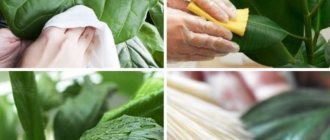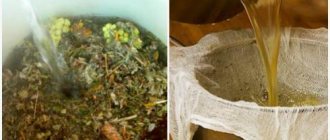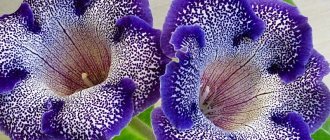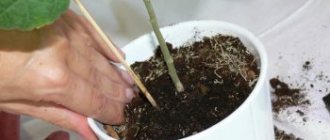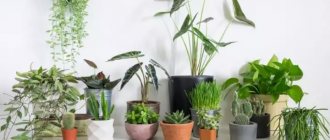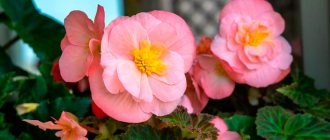Why is it so important to clean the leaves of indoor plants from dust?
Dust must be removed without fail. It interferes with the normal breathing of the flower. And if breathing is impaired, its normal growth stops. Dust and other contaminants also interfere with the penetration of sunlight and reduce their amount. And without light, as everyone knows, a plant also cannot grow and develop normally.
As a result of all this, the amount of chlorophyll decreases, which leads to the occurrence of diseases. As a result, the leaves turn yellow and wither, the flower stops growing and eventually dies.
Another reason is that the plants are deprived of rainwater. Therefore, cleaning leaves from dust is very important. This cleansing should be done at least twice a month.
How to clean plants with “fluffy” leaves?
It is necessary to select domestic crops whose foliage is covered with lint. These include geraniums, achimenes, violets and other plants. It is not recommended to wash them often - the foliage dries out problematically (the droplets are retained by fluff), which results in problematic situations. For example, sunburn or rot.
But you can’t help but fight the settling dust! To preserve the decorative appearance of a violet, you usually have to work hard. Tilt the flower and brush away dirt from its center, remove dusty deposits with a soft brush.
Every two to three months you only need to have a “shower” once. But make sure that the plant dries in a warm and dark room. And, of course, drafts are strictly prohibited.
Why are indoor flowers so useful for the home?
Laminate and linoleum, electrical appliances, plastic - all this can hardly be called environmentally friendly household items, especially when it comes to budget choices. Experts warn about traces of formaldehyde in finishing materials, and society is actively listening to their recommendations. Today it is considered more reasonable to restore grandma's sideboard or oak table than to buy a new, cheap piece of furniture.
Flowers and plants are becoming one of the main natural inclusions of a modern interior. They form a natural decor, living and changing.
Any color scheme can be enlivened by ficuses and dracaenas, citrus fruits and chlorophytums. And this is not only beautiful, but also useful.
Let's look at why indoor plants are so useful for the home:
- Residents of megacities cannot rely only on apartment ventilation. The air outside the window is saturated with exhaust gases and emissions from industrial enterprises. Many plants are capable of absorbing harmful substances and even releasing phytoncides that kill microbes.
- In the average apartment there are many devices that produce electromagnetic radiation: a computer, a microwave oven, a TV, a mobile phone, etc. Long-term exposure to radiation certainly affects the well-being of household members. Headaches, insomnia, fatigue - this is often how it manifests itself. Plants that purify the air do an excellent job of solving this problem. At least some of the electromagnetic radiation is absorbed by the home garden.
- In winter, heating radiators dry out the air. People see the consequences of this on the condition of the skin, on dry mucous membranes. Houseplants purify the air.
- In a house where there are smokers, plants are also appropriate. They help clear the air not only of dust and toxins, but also of tobacco smoke.
- The phytoncidal properties of plants are underestimated by those who prefer artificial analogues to natural flowers. Yes, the latter can be very decorative, but they do not highlight anything at all. And, in fact, they are just collecting dust.
Finally, vegetation in the house does not require high maintenance costs: neither financial nor time. Even very busy people will not find it a burden.
Apartment detox: figuring out which plants purify the air
What plants purify the air most effectively?
Strictly speaking, all the greenery growing in your home cleans the air, at a minimum, of carbon dioxide CO₂ - the carbon dioxide that we exhale. In return, it produces oxygen. But, most likely, your home is equipped with the latest technology, and in its air there are much more dangerous substances released from carpets, wallpaper, plastic, furniture, rubber and cleaning products. Agree, it’s not entirely pleasant to discover that in your designer interiors, among leather sofas and shimmering crystal chandeliers, there are vapors of benzene, formaldehyde, toluene, xylene and trichlorethylene floating around. Add to this bacteria, mold and dust. It turns out that “home, sweet home” is not even “sweet”: the air in it is contaminated with harmful impurities that poison you every day. A simple and effective way to improve your home environment is to have plants that purify the air.
"Green helpers" that purify the air
Currently, indoor plants as natural filters are the most reliable and safe assistants in purifying the air from various harmful impurities. The most effective of them are the indoor plants presented below.
DRACENA MARGINATA
This variety of dracaena is very common and can reach a height of up to 3 meters. The dracaena itself resembles a miniature palm tree. This plant feels comfortable in both bright sunlight and diffused light. The soil should not be soggy, but it should be sufficiently moist. Water in the pan is destructive for dracaena.
Pelargonium ivy
Pelargonium (geranium) perfectly cleanses, ionizes and disinfects the air. In addition, for many it serves as a cure for headaches. Geranium requires high light and abundant watering. However, the plant rejects surface spraying and requires lower temperatures in winter.
CHAMEDOREA HIGH
This plant is a palm tree that can reach a height of 1-2 meters. The plant releases moisture into the air, which makes it especially useful in dry air during the heating season. Despite the fact that this palm tree responds positively to bright light, it is best not to place it in direct sunlight. The soil must be kept moist.
SPATHIPHYLLUM WALLIS
This indoor plant does an excellent job of purifying the air, and its unusual flowers also take part in this. Spathiphyllum does not tolerate bright light, loves shade and requires high humidity. The soil should be slightly moist at all times.
EPIPRENUM GOLDEN
This is a vine that can be 2 meters or more in length. Epipremnum aureus is considered one of the most effective plants that purify the air in the house. It grows in any light, but is afraid of direct sunlight. It should be watered as the soil begins to dry out. When the plant reaches a great length, it is recommended to remove the tendrils.
HEDERA HELIX
This plant is a climbing shrub that can be easily grown in hanging pots. Hedera is excellent for combating indoor allergens such as mold. This shrub is the plant of choice for low-lit rooms, but it needs to be watered abundantly and the soil must be constantly kept moist. In winter, the frequency of watering decreases.
AGLAONEMA MODERATE
Aglaonema is interesting because it produces red fruits, which significantly increase its decorative qualities. The plant loves high humidity, well-drained soil and indirect light. You can place the aglaonema in a tray of water, placing the pot so that it does not come into contact with the water. Before watering, you should make sure that the top layer of soil is dry, since the plant feels comfortable only with moderate watering.
CHLOROPHYTUUM CRESTATES
Chlorophytum is considered the most unpretentious indoor plant. The plant has long and narrow white-green leaves, as well as hanging airy tendrils with short shoots. Grows well in both light and shade. In the light, the leaves become bright. You can rarely water it. Then the chlorophytum will absorb moisture from the roots. With more frequent watering, it grows faster.
SANSEVIERIA THREE-STRIPED
Sansevieria is considered a very hardy and long-lasting indoor plant. It has long, stiff leaves of a dark green color with horizontal stripes that are lighter in tone. This plant loves bright light and during growth prefers moderate watering, when the top layer of soil has already dried out. In winter, the frequency of watering is reduced, but it is not recommended to allow the soil to dry out completely.
FICUS ELASTIKA
The leaves of this plant are usually wide, shiny, dark green or variegated. Its aerial roots have the ability to wrap around the trunk, forming interesting shapes. Ficus elastica grows in bright, indirect light and requires moderate watering when the soil is slightly dry.
It should be noted that all these indoor plants are far from alone in their ability to release oxygen and purify the air of harmful substances. These are just some examples of such plants. In addition, each of these natural filters represents one specific variety of the same plant. So, for example, dracaena can also be Tree-like, Fragrant, etc. But regardless of the type of dracaena, its ability to remove benzene and formaldehyde impurities from the air remains intact. The same goes for other plants. Therefore, the room can be decorated with the same plant in its different types. What other plants can become your helpers in landscaping an apartment or house, maintaining comfort in it and, most importantly, normal ecology?
Kalanchoe
This plant will not only make the air in your room cleaner and safer, but will also delight you with beautiful bright flowers. The medicinal properties of Kalanchoe are widely used in folk medicine. It helps to cope with a runny nose. In the room where this flower is located, practically no pathogenic organisms are found.
Like any flowering plant, Kalanchoe loves bright light. During the flowering period, it needs to be watered more often than usual.
Aloe
If you don't have this houseplant, be sure to get one. Aloe removes formaldehyde from the air well and helps with colds and runny nose. It is enough to put a few drops of juice into the nose for prevention and treatment.
Chlorophytum
This indoor plant is not afraid of a polluted environment. Chlorophytum is not only an interior decoration, it actively purifies the air.
The home flower has proven itself to be a good fighter against dust and harmful microorganisms. It absorbs all toxins released by synthetic materials.
Buy an adult flower. For a three-room apartment, a few pots of Chlorophytum are enough.
Geranium or pelargonium
The plant copes well with pathogenic microbes and bacteria in the air. Geranium has a beneficial effect on the human body, improving sleep and calming the nervous system. The aroma of geranium refreshes stale air and repels flies. Geranium is also capable of absorbing carbon monoxide and dampness. An indoor flower is great for the bedroom and also the kitchen.
Dracaena
Varieties of dracaenas:
- Dracaena marginata,
- Fragrant dracaena (Dracaena fragrans "Massangeana"),
- Dracaena deremensis "Janet Craig"
- Dracaena deremensis "Warneckii"
These are plants of different shapes and sizes. Dracaena fragrant "Massangeana" reaches a height of 1.5 m and has a beautiful yellow stripe on the leaves. Dracaena marginata is one of the most common varieties of dracaena, can reach 3 m in height, it resembles a miniature palm tree.
Care: different types of dracaenas have different attitudes to light. Before purchasing, find out the plant's preferences. The soil should be moist, but not soggy. Water in a tray is fatal to dracaena. In summer and spring you can fertilize with universal liquid fertilizer.
Eliminates: formaldehyde, xylene, toluene, benzene, trichlorethylene.
Scheffler
A beautiful indoor plant that neutralizes tar and nicotine released when smoking. An indoor plant that purifies the air from tobacco smoke, suitable for rooms where people smoke.
Citrus
Many people have probably tried to grow tangerines or lemons at home. And such an activity can be successful in a certain way. Even if your tree grows to only 1.5 m, it will be very beautiful. Under certain circumstances, citrus fruits can even bear fruit. They perfectly clean the air in the apartment from bacteria; they are called natural disinfectants. They will also become natural aromatherapy at home.
Care requirements:
- citrus fruits need a deep and spacious flowerpot, and the tree will have to be replanted every 1-2 years;
- Citrus fruits require moderate watering;
- Do not place the plant near heating radiators;
- light-loving citrus fruits do well in full light, but it’s also impossible to say that they are afraid of dark places.
A lemon tree is often grown in a nursery, but on the condition that the owners of the nursery are already at the age when they themselves can water the tree and care for it together with their parents. It will be very interesting for the children to watch the process of lemon growth.
Ficus benjamina
A strong trunk with delicate bark, thin branches and quivering leaves - this small tree is found in homes, offices, and other public buildings. A well-groomed plant looks great, decorates the interior, and looks like a self-sufficient natural decor. It perfectly cleans the air of dust accumulated in it. Ficus also resists harmful compounds released by plastic.
How to care for ficus:
- there is no need to move it often: determine a permanent place for the tree and do not change it, otherwise the ficus may shed its leaves due to stress;
- the optimal temperature for the plant is +20 and a little more; the ficus is afraid of drafts and sudden temperature changes;
- the plant loves the sun, but does not tolerate direct sunlight;
- You need to water it 1 or 2 times a week, only with warm water.
An attractive, large, yet graceful plant most often decorates the living room.
Spathiphyllum
A useful, beautiful plant with pointed leaves. During the flowering period, buds form on its stems, from which delicate white or pinkish flowers soon appear. The shape of these flowers resembles a heart, which is why lovers often give this plant to each other.
Caring for spathiphyllum involves:
- moderately warm climate in the apartment, protection from drafts;
- loose soil with dry river sand;
- not too much watering, but regular soil moisture;
- sunlight, although even in a shaded area of the home spathiphyllum can grow well.
The plant is unique in that it resists the harmful effects of mold, formaldehyde, trichlorethylene and other toxic elements. It can live anywhere except the kitchen: it is dangerous for it to be there due to temperature changes.
Dust must be removed regularly
The frequency of anti-dust treatment depends on the cleanliness of the air in your home. If it is located next to a busy boulevard, or there is a construction site nearby, then you should wipe off the leaves much more often. The best way to tell if it's time to care for your flowers is to rub the leaves with your fingers. If there is still dust on them, then it’s time to act.
How to properly care for flowers at home
Today it is difficult to find at least one house or apartment without indoor flowers.
.
And despite the fact that keeping flowers at home is very popular, fashionable and beautiful, some housewives do not even suspect that there are certain subtleties of growing flowers at home.
Lack of necessary knowledge
can lead to the fact that flowers may begin to hurt, dry out and die. Therefore, you need to learn how to care for flowers correctly so that they continue to delight the eye with their lush blooms and healthy appearance.
Caring for home flowers
is a certain process that requires a serious approach to the matter. It is important to prevent the flower from getting any diseases, because a diseased plant can easily infect its neighbors on the windowsill and even those in the next room or even apartment.
Many people believe that proper care
- this is feeding, watering the plant, pruning it and other similar work. But in fact, there are still many factors that influence houseplants to remain beautiful and healthy.
Dust must be dealt with correctly
Spraying helps a lot. The easiest way to free indoor plants from dust is to place them in the sink (large ones in the bathtub) and spray them there with a spray bottle. Test the water to make sure it is lukewarm before spraying: hot or cold can damage leaves equally. If the plants are very dirty, you can spray them with soapy water in a ratio of 1/4 cup of liquid soap per 1 liter of water.
Plants with large leaves can be treated on site. To do this, you will need to wipe each leaf with a damp soft cloth.
During anti-dust treatment, you can also remove dried, yellowed leaves. Some are easy, for others use scissors, but under no circumstances tear them off.
You can also trim off the brown ends. Plants will look more natural if you follow the outline of the leaves when cutting away dead parts.
The leaves of some house flowers are difficult to clean. If spraying is contraindicated, you should use a soft brush or dry sponge to remove dust.
It is important to take care of the soil
You need to take care not only to clean the leaves of plants from dust, but also to ensure that the pots in which they grow are of the correct shape and the soil is fertile. If you notice that a white coating has formed along the edges of the “flower houses,” you need to carefully remove the plant along with the soil and tidy up the pot.
To do this, you will need to wash it with a special solution (1 part bleach to 10 parts water), after removing any remaining dirt with a stiff brush, and then dry the container thoroughly. Only after this can the plant be returned to its place.
At first it may seem that all this is difficult, but you will soon discover that maintenance cleaning does not require excessive effort, and the result will be pleasantly surprising. It turns out that keeping indoor plants in perfect condition is not such a difficult task even for a novice gardener.
Photo: Pixabay
Polishing the leaves
Making leaves shine with industrial preparations
It is customary to polish the leaves of some indoor plants. To make the leaves glossy, you can use both industrial polishes and folk remedies. However, shine can only be applied to smooth leaves with a flat surface, that is, to leaves that are devoid of even the slightest pubescence. Such plants include palms, crassulas, dieffenbachias, large-leaved ficuses and ivies, philodendrons, monsteras, aspidistras, and nematanthus. But the leaves of Saintpaulias, pelargoniums and decorative deciduous begonias do not need shine.
Industrial products for adding shine to leaves are available in the form of a liquid or spray and have a prolonged effect, that is, they provide the leaves with a healthy appearance and gloss for a long time. Almost all companies that produce fertilizers also produce leaf care products. The difference between polished leaves and untreated leaves is huge. Moreover, industrial polishes are complex, broad-spectrum preparations that not only make plant leaves beautiful, but also protect them from diseases and pests by covering the surface with a protective film.
To polish large leathery leaves, such as those of monstera or ficus rubber, liquid polishes are used, which are applied by hand, and for plants with small, openwork, carved, dissected or very thick leaves, aerosols are used.
Before you start polishing, carefully read the instructions and strictly follow the recommendations contained therein. Apply polish to dry leaves that have been previously cleaned of dust and dirt.
You should not use polishes more often than indicated by the manufacturers, since the layering of the composition harms the leaves more than dust or dirt.
First, polish one or two leaves from the top side of the plate as a test (you cannot apply polish to the bottom side) and wait a couple of days: if the plant feels good after applying the chemical, apply gloss to all the foliage. Plants with leaves polished with chemicals should not be placed in direct sunlight: to avoid chemical burns, keep them either in partial shade or under diffused light.
How to choose plants depending on the interior?
Irina Volkova: “If you have rooms in the style of Napoleon III, you should think about purchasing plants of exotic forms (ferns, palms, monsteras): this is how aristocrats decorated their houses. In modern high-tech interiors, plants of simple shapes, with clearly legible leaves, directed upward, without sloppiness and drooping (for example, amaryllis and anthurium) will look good. Interiors in eco or loft style can be complemented by an assortment of plants planted in a large wooden box with forged fittings, or those same florariums. And if you suddenly want to add vanilla to your apartment in the spirit of Miss Umbridge from Harry Potter, pay attention to begonias and camellias, reminiscent of spray roses, as well as campanulas and azaleas, similar to miniature lilies. A suitable pot can still be found in IKEA, Crate & Barrel, Zara Home, H&M Home, as well as in the Wonderwood workshop or at florist centers such as the Azalea chain.”
Washing and showering
All indoor plants that are not afraid of getting wet love periodic showering. For large-leaved crops that can be wiped by hand, one such procedure per month or at least washing during general cleaning is enough. Small-leaved plants need to be showered or washed much more often, since it replaces manual cleaning.
The most difficult thing in any bath procedure for indoor plants is to protect the soil from getting wet and dirty. Even if you don’t plan to use soap solutions, dirt and dust along with water will get into the soil and in the future may become an additional factor in the appearance of problems in the development of plants. It is impossible to completely protect the soil, especially for plants with dense bushes or turf. But it is quite easy to cover open ground as much as possible and minimize damage from getting it wet. To do this, it is enough to use plastic film or a bag to cover all the soil around the perimeter of the pot, bringing the film as close as possible to the plant itself. For small containers and compact plants, you can simply cover the soil with your hand.
Edge and living velvet on the leaves
Plants with beautiful leaf textures are afraid of even the slightest drops of water. And wiping, let alone washing, is unacceptable for them. The purity of the greenery of such decorative deciduous and flowering crops is maintained by completely different means.
The main method of removing dirt from pubescent leaves is careful manual cleaning using a piece of soft velvet, a soft brush or special brushes with delicate natural bristles.
In emergency situations, for example, when plants have suffered from irregular care in the kitchen, their leaves are covered with a greasy coating, they were indoors during repairs, even on pubescent leaves it is necessary to wash them. True, we are not talking about showering: with the help of soap suds and gentle washing, dirt is removed, and then the plants are allowed to dry thoroughly, protecting them from bright light and low temperatures. Such washing is always a very serious stress and rarely ends with the return of the decorative properties of old leaves to their original ones. Before washing pubescent leaves, you should always carry out the usual dry cleaning of dust and dirt, and only then carefully wash them.
Cleaning the leaves of indoor plants from dust and dirt and adding shine


